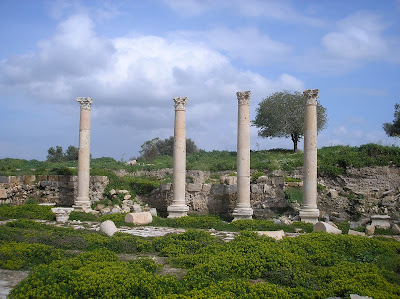
We had torrential rains here 4 days in a row about a week ago. And I mean torrential - biblical proportions. The effects of this kind of rainfall are exacerbated in a city where storm water/sewer grates are few and far between - you see roads become rivers very quickly. The good news is that this winter's rainfall has now surpassed that of the last 10 years or more and people at work are all talking about how the aquifers have been recharged.... (Folks talk about such stuff in a country that is one of the most water-constrained in the world).
One of the wonderful outcomes of the winter rains and the spring warmth is wild flowers. If you head away from the southern desert, up north towards the Syrian border, where the land becomes more and more fertile, and the hills get higher, you start to see carpets of lush green - wild grasses, wild geranium, lamb's ears - and masses of blooming red poppies, anemones, purple clover, yellow and white daisies, wild dwarf irises.
This, people have been telling me since I arrived, is the time of year to visit Umm Qais. So a friend and I went this past weekend. A small town that overlooks the Sea of Galilee and the Golan Heights, squeezed into the far northwestern corner of Jordan where it meets the difficult borders of Israel and Syria, Umm Qais was formerly the Roman city of Gadara, which flourished from the 2nd century BC to the 3rd century AD. In the 19th Century, the Ottomans scavenged blocks from many of the temples and built a fort and a village, now also abandoned and impressive.
Under the Greek empire and the Romans, the town must have been formidable. It stretches in all directions, overgrown ruins, too expensive to excavate, transformed now into meadows and olive groves. There are the remains of 3 amphitheatres, each of them with a capacity of 3000+ people. Much of the city was built from black basalt rock - not your usual white limestone or marble - and the ruins - temples, roads, city gates, churches, mausoleums - have a lovely, silent, mysterious quality.
What makes it particularly special in spring is the amazing wild flowers. And what is special about the wild flowers is not only how beautiful they are to look at, but the scent of them. The fragrance of the fields of purple clover in the spring sunshine was incredible. The stillness was amazing. After walking for several hours, we picnicked in a field overlooking the Sea of Galilee, and listened to the birds and sound of sheep bleating, musing at how a place so politically fraught can also be so incredibly peaceful.



I never really imagined biblical lands being so lush.
ReplyDeleteSea of Galilee? You are inhabiting a gospel song.
We are also having a wet winter and are looking forward to a spectacular wild flower season. Ours is a few weeks away though. Deserts can be quite amazing!
ReplyDeleteoh, and...
HAPPY BIRTHDAY HANNAH!
-Danbo
Beautiful, Hannah! And how do you know the names of all the wildflowers? Are these your rural Ontario roots showing? Impressive.
ReplyDeleteLeah
A trip to Leslie Spit will confirm it. Overgrown ruins are more picturesque without rebar.
ReplyDeleteI love comments! Thank you so much.
ReplyDeleteI do feel like I am living in a gospel song (man from galilee!) sometimes. On this day I had the biblical phrase "all men are like grass and their glory is like the flowers in the field.." running through my head. It took on new meaning.
Thanks for lovely birthday greetings!
My scant botanical knowledge I attribute to growing up with an English gardener for a mother who liked to walk in the woods. But really, daisies, poppies and clover are all pretty straight ahead!
I love the idea of the Leslie Street Spit as Umm Qais in 2000 years.
H